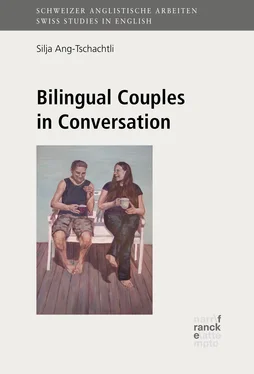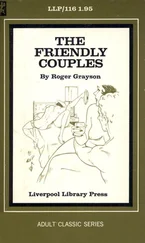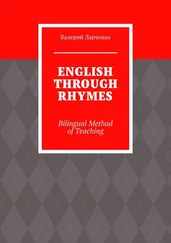1 ...7 8 9 11 12 13 ...23
3.3 Bilingualbilingualcouples couples: Background and challengeschallengeslinguistic
3.3.1 A word on bilingualism
Bilingualismbilingualism has been defined as “the regular use of two or more languages” (Grosjean 1982: 10), although it can also be defined based on competence in the second languagesecond language (L2). For individuals, I use the term bilingual bilingualindividuals to refer to the ability to speak two languages, which requires a certain level of proficiency and presupposes at least occasional use. When referring to bilingual couples, as opposed to bilingual individuals, I use the term to indicate that the partners have different mother tongues, regardless of both partners’ level of proficiency. Thus, bilingual couples may not communicate in two languages with each other; instead, they may often speak one main couple language. This also means that, in theory, one of the partners might not actually be bilingual, despite being in a bilingual relationship. Moreover, it should be noted that, technically, many of the participants in this study are not just bilingual, but multilingualmultilingual. Since my research only focuses on the two languages in which they are most fluent — their mother tongue and their partners’ L1first language — I will refer to them as bilinguals, and to their partners’ language as their L2, even if for some, this may not be the language which they acquired second. In contexts where I refer to any language (or several languages) other than a speaker’s L1 (and not specifically his or her partner’s language), I use the term LXLX.
While there is an abundance of research in the field of bilingualism, bilingual couples received little attention until the 1990s. As with research on cross-cultural couples, research on bilingual couples was conducted mostly from the perspective that they pose a problem (Piller 2002a: 19), and only in recent years have researchers begun to move away from the assumption that bilingual relationships are inherently problematic. In addition, most studies do not examine the manner in which bilingual couples talk to each other, but rather concentrate on one of the partners, most commonly the female one (see also section 3.2.2, “Bicultural couples”). An example of this is Heller and Lévy’s study of 28 Francophone women married to Anglophone men in Ontario, Canada. The authors examined the women’s language practices and their attitudes towards them, as well as their feelings about their own identities (1992: 20). Heller and Lévy found that the women reconstructed the French-English language border linguistically in their conversations, and that they did not necessarily assimilate to their partner’s culture (1992: 39). Some of them had a strong focus on their Francophone identity, while others attempted to construct and combine two linguistic identities.
Probably the most extensive study on bilingual, bicultural couples was conducted by Piller (2002a). She examined 57 German and English-speaking couples living in a number of countries, based on self-recorded conversations or monologues, questionnaires, letters and/or focus group interviews. In her analysis, she considered a number of aspects, including the couples’ reported language choice and mixing behaviour. Piller was concerned with the ideologies and other factors underlying these language choices (see section 5.2, “Factors influencing the language choice of bilingual couples”, for a more in-depth overview), and studied the participants’ reported language skills, processes of L2 acquisition and language ideologies, as well as their perceptions of their mother tongues. She discovered that many of the participants had a strong emotional attachment to their partner’s language, a feeling that she calls “language desirelanguage desire” (2002a: 100; see also section 7.2.1, “Attraction in bilingual, bicultural couples”).
Another focus of Piller’s research is the construction of bilingual, cross-cultural couplehood and identity. She posits that, because bilingual individuals often feel or think differently depending on the language they speak, bilingual couples may also view, experience, or performperformingcouplehood their couplehood differently. Like other identities, Piller argues, couple identityidentitycouple is not something fixed, but a hybrid construct that may be performed differently depending on the environment the couple is in (2002a: 11). Hence, “[c]ross-cultural couplehood is not a state of being, but an act of doing” (2002a: 2). Through detailed analyses of their speech, she demonstrated how the couples jointly constructed and performed their identity linguistically (2002a: ch 7). The couples did this on a conversational level, for instance by using their own private words, as well as on a discourse level, by reiterating “‘founding myths’ and stories they tell about themselves to account for their being together” (2002: 225).
Such linguistic strategies serve the partners to highlight similarities between each other and enable them to construct their couple identity, but they also discredit the prevailing idea of intermarriage as a problem (Piller 2002a: 189). The couples’ reports showed that they had all come across negative opinions of intermarriage, and that “they [were] aware of a widespread framing of cross-cultural marriage as problematic” (2002a: 186). In analysing the couples’ discursive strategies, Piller found that they used three major strategies to frame their relationships as unproblematic. Firstly, they contrasted themselves with other cross-cultural couples by highlighting the cultural proximity between English and German-speaking countries. They thus created a discourse that presented “European or Western culture as a homogenous cultural sphere”, and, in doing so, depicted their relationship as less problematic than other bilingual relationships (2002a: 194). Secondly, the couples sometimes “downplay[ed] national identityidentitynational and focus[ed] on other aspects of their identity”, appealing to non-national identities instead (2002a: 189). They referred to common historical roots of their cultures, to shared values or interests, to similarities between their personalities, or to their “shared linguistic identity as bilinguals” (2002a: 199). This discourse of collective identities allowed them “to construct themselves as conventionally and appropriately similar” (2002a: 197). Thirdly, some of them used a discourse of post-national identities, for instance by presenting themselves as cosmopolitans, world citizens or fellow Europeans (2002a: 202).
The couples in Piller’s study produced not only a discourse of constructing similarities, but also one of deconstructing differences or framing them positively. Hence, many described their cultural differences as attractive, exciting or exotic, or framed their being together as their destiny. Others portrayed themselves as atypical of their cultural background or as exceptions from their national stereotypical norm (2002a: 205). Moreover, the couples emphasized that they could overcome cross-cultural difference through compromise and change. In fact, Piller states that the “discourse of change and compromise is unique in [her] corpus in its frequency, as it appears in every single conversation, without exception” (2002a: 213). Thus, the couples seem to feel that “love should and must transcend [their] differences” (2002a: 2). In addition to the couples’ positive framing of their relationship, Piller claims that there is “no indication whatsoever in [her] data that the participants’ relationships are in any way more or less problematic for them than they are for any monolingual and mono-cultural couple” (2002a: 186).
A particularly interesting characteristic of the couples’ conversational style is their use of other-repetitionother-repetition and other-completionother-completion. According to Piller, “[t]he most salient feature of the transcripts […] is the enormous amount of repetition between speakers. All the conversations […] are characterized by high levels of repetition” (2002a: 228). Such other-repetition is generally seen as indicative of a collaborative floor, and is typical among people in a close relationship (2002a: 228). Piller examined the different functions of repetition and the situations in which repetition tended to occur, for instance as meta-linguistic comments, corrections, or as a consequence of word searches, word offers or mishearing. Bilingual conversations potentially provide more contexts for other-completion to occur, as there may, for instance, be more word searches (2002a: 235). Piller found that cases in which the partners finished each other’s sentences were also frequent in her data. The couples appeared to value other-completion, as instances thereof were “almost always endorsed by the recipient” (2002a: 237). Both other-repetition and other-completion, Piller believes, facilitate the discursive performance of a joint couple identity (2002a: 242).
Читать дальше












